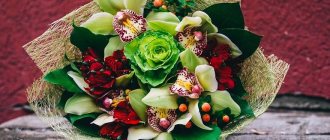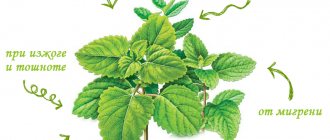What can be made from roses that have withered
If the flowers have bowed their heads, do not wait until they are completely dry. Get creative.
Dry your bouquet for an elegant arrangement in vintage tones.
. To do this, place the flowers with their buds down in a cool room. In a few weeks they will turn into dried flowers in muted pastel shades. Spray plants with hairspray to increase their strength and add a glossy shine.
Create a decoration from spray roses
or interior decor from a large Ecuadorian bud. To do this, fill the inflorescence with epoxy resin and wait until it hardens.
Place the buds in a white envelope, then under a press and leave for 7-10 days. Make unusual dried flowers for creating cards, bookmarks or paintings
. This advice is suitable for those who have children. Surely no one will have such an applique at school or kindergarten.
Drying dried flowers in a suspended state
The most popular method of drying flowers for decoration is to hang them dry. Before drying, flowers must be carefully prepared. To do this, remove all rotten leaves, extra leaves, and thorns. The flowers are tied with an elastic band and hung at a distance of 20 cm from the ceiling with the buds down. To hang flowers, they are attached with wire to a rope at a distance of 3-5 cm from the end of the stem at a short distance from each other. You can dry flowers in a bouquet or one flower at a time.
For maximum results, it is advisable that you have a dry and dark room with good ventilation, and the temperature reaches from +10 to +18 degrees. Such compositions usually dry for 2-3 weeks, after which they are covered with hairspray.
What to make from rose petals
Flower petals are much more often used in handmade products compared to buds. And the uniqueness of the rose is that its petals have not only decorative, but also medicinal properties. Therefore, we will give examples of how to use them both in cosmetology and for design.
What to make from rose petals: benefits for the face
Let's make a reservation that for cosmetic purposes you should use flowers that you grew at home and not bought in a store. This way you will be sure that there are no chemical impurities in the plants.
Dried rose petals are used in cosmetology. Wash and dry them, place them on parchment paper and place them in the oven at minimum temperature. In a few minutes, all the moisture from the cells will evaporate. The petals will turn out brittle and crispy like chips. Now you can use them to make various cosmetics for the face and skin.
Pink water
. Pour half a cup of dried petals into 5 cups of water, bring to a boil and cook for 10 minutes. Strain the solution and wipe your face. Water refreshes and soothes the skin, relieves redness and irritation.
Rose oil
. Pour olive oil or sweet almond oil over the petals until it covers them by 5 centimeters. Seal container and store in a dark cupboard for 4-6 weeks, shaking every 2-3 days. Add oil to creams or apply to moisturize dry skin.
Cleanser
. Crush the petals into crumbs, mix with water and honey until the consistency of thick sour cream. Apply on face for 10-15 minutes, rinse. The mask has an antioxidant effect and removes toxins from the skin.
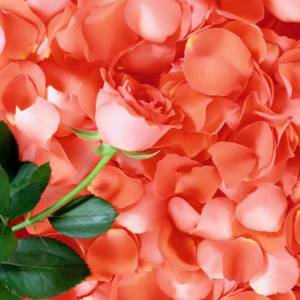
What can be made from rose petals: ideas for the interior
A sachet of rose petals will add a unique aroma to your room or clothes. Add cinnamon sticks and lavender sprigs, a few drops of your favorite aromatic oil and enjoy the fragrance.
Transform regular plain candles
. To do this, cover them with a layer of melted paraffin with the addition of flat inflorescences and pink petals.
Finally, let’s remember the easiest way to use rose petals - create a sensual and romantic atmosphere
, covering your bed, dining table or bubble bath with them. This use fits best with the symbolism of the rose, as it signifies love and passion.
Good afternoon, dear readers!
How many times have you had to throw a slightly wilted bouquet of fragrant and lovely roses into the trash bin? Remember how you felt at the same time! In fact, these flowers deserve more respect: it’s all about the amazing properties of their petals, which have various uses. Prepare rose petals: find out what you can do with them in this article!
Flowers as a giftMaking artistic panels from dried flowers
Dried plants can be used for panels, decorating picture and photo frames, and miniatures on greeting cards.
For drying, you can take field, forest and garden plants. Of the wild ones, cornflowers, speedwells, anemones, bells, buttercups, forget-me-nots, and daisies retain their color better; among garden ones, astilbes, delphiniums, annual dahlias, daffodils, marigolds, crocosmia (Montbrecia), and rudbeckias. As an additional material, you can dry the leaves of trees and shrubs of various shapes and colors (acacia, hawthorn, red oak, maple, mahonia, rowan).
To create a panel you need glue, tweezers and a thin brush. The background for the panel can be a sheet of velvet paper or whatman paper (with the necessary shade previously applied on it with colored pencils with a transition from dark at the bottom to light at the top), canvas, black velvet or cloth, silk of gray, blue or another tone, successfully harmonizing with the color of the flowers compositions. Bright yellow or orange rudbeckias look beautiful on black silk, and pansies look beautiful on light blue silk. A neutral gray background is suitable for almost all compositions. Before starting work, the material that will serve as the background (and it should be 2-3 cm larger than the size of the cardboard) should be stretched onto the cardboard or glued and sewn on the back side. The paper is cut according to the size of the frame for the panel. On the prepared base, flowers and additional arrangement elements are carefully laid out with tweezers, and their most successful location is selected. Then the placed plants are lifted with tweezers and a drop of glue is applied under them. When all the flowers and leaves are glued to the background, glass from the frame is placed on top, and the entire composition is left for a day so that the plants stick well. The next day the panel is inserted into the frame. In order for the fabric to hold well in the frame, you need to secure it on the back side with cardboard or whatman paper. When decorating glass doors with dried plants, the composition can be double-sided. In this case, two glasses are needed.
To decorate a plastic lamp, plants are glued to the top and then coated with colorless varnish.
To create greeting cards, take cardboard or whatman paper, fold it in half (15X8 cm in size) and make a miniature of small flowers and leaves in the upper or lower corner. You can even use individual petals, blades of grass or pieces of openwork leaves. This could be a bouquet, an openwork wreath or a fancy combination of flowers and leaves. It is important not to overload the panel with plants; it should be elegant and compatible with the background. As an example of plant placement, you can use art postcards or photographs from books and magazines.
Interesting wall panels can be made from fallen autumn leaves of trees and shrubs. The leaves are wiped, the dried leaves are wrapped in a damp cloth, then ironed through the paper and placed under a press for final drying. A branch of a peculiar shape is first cleaned, excess shoots are removed and dried. The prepared branch is placed on the table, beautiful leaves are selected and placed near the ends of the branches. First, the leaves are glued closer to the middle of the branch, then at its ends. Having chosen a place to glue the leaf, press the petiole to it, wrap it with thread, and tie or glue the ends. “Blooming branches” are very decorative. For them, it is better to use bergenia, delphinium, crocosmia, freesia, mock orange and other plants that retain their color well when dried in sand. For miniature branches, small flowers of acroclinum, ammobium, kermek, sandy cinnamon, etc. are good. For thin branches, flowers and fruits of vesiculus and cyanosis are suitable. Dried flowers and leaves are prepared in advance and sorted by color intensity, size and shape (open, half-open, buds). The pedicels are greatly shortened or completely cut off. A drop of glue is applied to the branch or the underside of the flower is smeared and attached. Smaller and brighter flowers are attached closer to the ends of the branches, buds - at the very end of the branch.
Recommended articles:
— Winter bouquets
— Methods for drying plants while maintaining volume
— Methods for drying flowers while preserving their natural color
— Autumn bouquets
— Chrysanthemums - autumn flowers
— Panels and postcards made of dry leaves
Healing properties
Speaking of roses, in Russia they were used as a universal healing agent, and later, they found their own application in the field of cooking. Many people remember the unusual taste of rose petals in jam or the aroma of rose water. In addition, essential oil is extracted from this magical plant, endowed with a large number of beneficial properties.
Why is Rose a doctor? This is justified by the active substances it contains. Namely, from 1 to 18% of various sugars, such as sucrose, glucose, fructose. About 4% pectin and organic acids. High content of phenolic acids and tannins. A huge amount of B vitamins are contained in this color, PP vitamins and pantothenic acid.
How to collect and dry rose petals
Very often in stores we can see petals already collected and dried. Don't buy them. Because, perhaps, the rules of collection and drying are violated, and, therefore, their necessary parameters are lost. Rose petals should be collected in clear weather, when there is no rain, in the morning, as soon as the dew has disappeared.
We do this as quickly as possible, because if you delay, you can lose many of the necessary properties of the plant. Petals that are collected at midday, of course, lose up to 30% of their essential oil.
We dry them in the shade and only in cool air, but you can do this in a room, but your ventilation must be good. Once dry, place them in a dry jar and store them there. If you took a lot of petals, you can use the freshest ones to make, for example, jam or another dessert that is no less tasty.
Use of rose petals
Fresh and dried petals are suitable for making cosmetics. If the product is made from dried raw materials, the flowers must first be ground in a coffee grinder. Fresh roses are crushed only for the cream or mask; in other versions, whole petals can be used.
The effect will be better if you steam the skin first. A bathhouse, sauna, steam or hot bath is suitable for this.
Bath with rose petals
The most common way to rejuvenate the skin is a rose bath. This helps relieve fatigue after a hard day, softens and tones the skin. A light, sweet aroma will help calm the nervous system. Such baths are recommended for people exposed to frequent stress. Fresh flowers can be added specifically to the water. Recommended water temperature is 40 degrees.

Dry petals should be prepared in advance. The raw materials are crushed, filled with water and placed in a water bath for 20 minutes, covered with a lid. To prevent small particles from interfering, the decoction must be filtered before use.
To make sea bath salts, you need the freshest petals. For 200 g of salt you need 5 rose buds. The ingredients are combined, placed in a glass jar with an airtight lid and left in a warm place for 14 days.
To prepare water for morning washing, you will need 2 handfuls of raw materials. The flowers are poured with warm water and left for 6-8 hours. The new petals can be used as a stand-alone tool. It is enough to pass them through a meat grinder, and the refreshing mask is ready. Before application, it is necessary to clean and steam the skin.
Rose petal remedies
- Ice. Dry petals can be used to make cosmetic ice; this is an excellent tonic for the skin of the face and décolleté. A handful of raw materials is poured with 250 ml of boiling water and left for 20-25 minutes. After which the water must be filtered, poured into molds and placed in the freezer. Ice is used twice a day.
- Rose syrup. Prepare 1 kg of the freshest rose petals. To do this, carefully select the freshest and longest-lasting buds, then rinse them with cold water. Place them in an enamel frying pan and pour 9 liters of hot water. Boil water with petals and wait until they lose color. Remove from heat. Add 4 kg of sugar to rose water and return the solution to the fire: remove after 10-15 minutes from boiling. Usually it's time to extract the syrup on which a film has formed. Pre-pour the finished syrup into sterilized jars.
- Tea. Many people are interested in the question: is it possible to brew tea with rose petals? Yes! Here is the prescription. This is the so-called Persian rose tea, which is based on rose petals and dark tea leaves. Simply pour the two ingredients in a 1:1 ratio with the desired amount of boiling water and let the drink cook. A drink prepared according to this recipe will be a wonderful addition to any tea party and will appeal even to capricious “tea gourmets”.
- Jam. Rose jam recipe. You will need: 100 g of the freshest tea roses, grown in your own garden and not treated with pesticides; 1 kg sugar lemon juice and zest; a few drops of rose water. Place the rose petals in a sieve and wash well. Then use sharp scissors to carefully trim the white part of the petal. Place in a frying pan, add 350 ml of cold water that has passed through a filter (you can use bottled water), add half a squeezed lemon. Place on low heat, cook for 3-4 minutes. Then you need to add sugar, stir, boil again, then pour in the remaining juice and continue cooking for about 20 minutes, then add the zest and cook for another 20-30 minutes until the syrup becomes thick. Add rose water, mix well, turn off the stove, wait until the jam has cooled, then pour into jars.
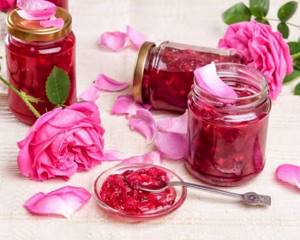
- Lotions with a touch of nature. What can you do with pink rose petals? Prepare the tonic! Pour boiling water and 1 tablespoon of glycerin into half a glass of crushed petals. This is a great lotion for washing. Cosmetologists recommend cleaning the face and neck area with a ready-made solution.
- Cosmetic rose tea. Is it possible to brew tea with rose petals? A traditional recipe for cosmetic rose tea: pour a few tablespoons of finely chopped rose petals into 200 ml of boiling water. Leave for 20 minutes. The finished tincture can be placed in an aerosol can and refreshed with water or frozen in a mold, thereby preparing cosmetic cubes: they serve to prevent the formation of wrinkles.
- Skin product. If you pour finely chopped 1 glass of petals into 200 ml of vodka, leaving the solution to infuse, after 10 days a skin cleanser will appear. Before use, the infusion is diluted with 2 teaspoons of chilled boiled water.
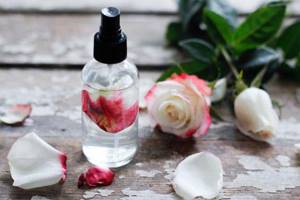
- Freshener. Instead of using the usual chemical air freshener, you can make your own natural ones. An important condition: the buds must have a strong aroma. Take the jar and place the petals down. Sprinkle a thin layer of sea salt. Place the petals again. Continue until you reach the top of the jar. . Experiment with colors, but stay away from flavored salts. Close the jar. Place in a cool, black place. Shake occasionally. After a week you can use it for its intended purpose. Just open the lid slightly.
Mask recipes
- First recipe. A jar with five huge rosebuds should be filled with boiling water. Leave for 20-30 minutes. Dissolve rice flour and oats in the prepared tincture: add these ingredients until the mixture becomes mush-like. Apply the completed mask to the skin of the face, neck, chest, and after half an hour, rinse with running water. After the mask, moisturize your skin with cream.
- Second recipe. Experts say that rose petals have a nourishing effect on all skin types. We suggest making a mask from pink flour. To do this, grind the petals in a blender. Dilute 1 tablespoon of flour with half a teaspoon of low-fat sour cream (you can use cream) and add 1 teaspoon of chicken protein. Mix all ingredients thoroughly. Now the mask is applied to clean skin for half an hour, after which it is washed off with water.
- Third recipe. Making a mask that helps narrow skin pores is done as follows: 1 chicken protein is mixed with 1 tablespoon of honey, 2 tablespoons of flour and a few drops of rose oil. Already after the first application, which lasts 25 minutes, significant progress in reducing skin pores is noticeable.
How to preserve flowers in glycerin
You can stabilize flowers in glycerin yourself. There are two methods - with the flowers completely immersed in glycerin or with only the buds preserved. For both methods, glycerin is diluted with hot water in a 1:2 ratio.
When the water has cooled, a flower with a split stem is placed in it. After this, it is advisable to cover the buds with a bag and put them in a cool, dark place. Then your flower will not wither in advance, without having time to be saturated with glycerin. Glycerin can be tinted with a special dye. Also, every day for two weeks the stem of the flower is trimmed a little.
The second method involves completely immersing the flower in a container with the prepared solution. After the first week, the solution must be changed to a new one. It is also advisable to store the flower in a cool, dark place. The container is pre-treated with boiling water to remove bacteria and is hermetically sealed. After 14 days, the flowers can be removed or left in the solution.
What is the best method to use to preserve the shape of flowers?
If you are pursuing the goal of placing flowers in a vase after drying, it is especially important to preserve the original shape of the plants. For this, the best methods for drying are the paraffin and glycerin methods, as well as the method of conventional hanging drying in a well-ventilated area. After all, the less pressure is applied to the flower, the better it retains its shape. Also, drying with semolina and silica gel allows you to preserve the original shape of the flowers.
